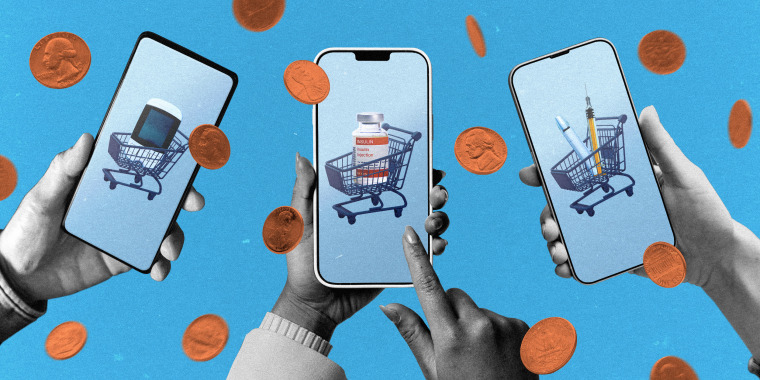When Rena Rossi, 41, was diagnosed with a rare type of diabetes at age 36, one of the first things she did was seek out other people living with the illness. The easiest way to do that was through social media and online groups dedicated to diabetes.
The groups she joined and the accounts she followed had what one might expect: information about different equipment and medications and posts about difficult days and triumphs.
But something else surprised her: thousands of posts asking for the arsenal of supplies people with diabetes need to stay alive.
Right away, Rossi said, she knew she would help when she could.
“I knew I was going to share when I saw a need. That’s how the community works,” said Rossi, a teacher in Rhode Island.
And share she did.
“I’m at the point now where I’ve had messages on Instagram from people I had never even heard of because people know that I know people who have stuff,” she said.
Without anywhere else to turn, online communities dedicated to people living with diabetes often become platforms where those in need of insulin and other diabetes supplies can connect with those who have extra. Sometimes, used equipment — such as insulin pumps and glucose monitors — is for sale at deeply discounted prices. Other times, people like Rossi have extra insulin that they’ll donate to people who can’t access it.
“I’ve shipped it to friends in Colorado, Florida and Seattle and have shipped it to people I didn’t know,” she said. She usually hides it among packets of applesauce.

Insulin can be expensive even for people with insurance
It’s illegal for people who aren’t prescribing doctors to give someone else prescription medical supplies or drugs in the U.S., but huge hurdles to accessibility have led to a thriving underground trade for diabetes supplies.
In 2021, 1 in 5 adults who use insulin reported rationing their supplies — skipping, delaying or using less than was needed — to save money. Even with insurance, people with diabetes may have steep copays for insulin.
The Inflation Reduction Act took steps to lower those costs, capping the monthly out-of-pocket cost of insulin at $35 a month, but the provision applies only to people on Medicare, leaving millions behind.
In his State of the Union address on Tuesday, President Joe Biden called for extending that cap to everyone.
“There are millions of other Americans who do not or are not on Medicare, including 200,000 young people with Type 1 diabetes who need this insulin to stay alive,” Biden said.
“Insulin isn’t the type of medication you can go two to three days without. People have to get insulin in some way,” said Dr. Laura Nally, a pediatric endocrinologist at Yale Medicine who is researching how people cope with difficult access to insulin.
But insulin isn’t the only financial burden for someone with diabetes. Glucose monitors, glucose strips or sensors and insulin pumps are needed to track blood sugar levels and automatically deliver small doses of insulin. The equipment can cost thousands of dollars every year.
“If someone has Type 2 diabetes, on top of that they may have pills,” said Michelle Litchman, the medical director of the Intensive Diabetes Education and Support Program at the University of Utah in Salt Lake City. “People are priced out of being able to take care of themselves.”
It’s unclear how widespread diabetes trading is; Rossi estimated that thousands of people are involved.
There’s also not much by way of research.
Litchman led one of the only studies on the subject. The study, published in 2019 in the Journal of Diabetes Science and Technology surveyed about 160 people who had traded diabetes supplies. Nearly 60% had donated supplies at some point, and nearly 40% had received supplies from others in the community.
“One of the things that surprised me the most is that people who were insured were doing this, too,” she said. “Insurance doesn’t necessarily protect you from having to engage in this type of activity, because even with insurance, copays can be outrageous, and they add up.”
In the event that someone runs out of insulin before he or she is due for a new prescription, getting more of the medication can be extremely expensive and difficult to access.
Read more about insulin costs in the U.S.
- Why is insulin still so expensive in the U.S.?
- Nearly 1 in 5 U.S. adults with diabetes ration insulin to save money
- Insulin costs will be capped in 2023, but most people with diabetes won't benefit
Nally, who has had Type 1 diabetes since childhood, said that “every year for about one month, I have to contact insurance and durable medical equipment companies over and over again to get my supplies.”
Insurance typically covers only a 30-day supply of sensors for continuous glucose monitors, which automatically check blood sugar levels, leaving people without vital equipment if sensors are damaged. “If you have an insulin pump that talks to your continued glucose monitors, then you can’t use that, either. It’s a huge safety risk for patients,” Nally said.
Or insurance may cover just part of the equipment needed for a particular piece of technology.
When he was still on his parents’ insurance, Erik Douds, 31, who was diagnosed with Type 1 diabetes as a teenager, had a prescription for a continuous glucose monitor made by a company called Dexcom, one of the main suppliers in the U.S. His insurance would approve one part of the instrument — the sensors that stick on the body and read a person’s blood sugar every few minutes — but not the transmitter, which relays that information to a person’s phone or insulin pump.

“I would have boxes and boxes of sensors, but I couldn’t use them without the transmitter. That was the first time this began,” Douds said. “I needed a solution to this, and I didn’t know where to find it.”
America’s Health Insurance Plans, or AHIP, a trade group that represents insurance companies, did not respond to a request for comment from NBC News.
Douds learned about supplies trading when he was living in New York City, after he joined an online MeetUp group for people with diabetes.
He first tapped into the network in 2017, when he was riding his bike across the U.S. Because insurance coverage changes by state, he was often left without the diabetes supplies he needed. Douds remembers meeting up with someone he met online, a prominent diabetes blogger, in a parking lot in California to get transmitters for his glucose monitor.
Right now, it’s easier for me to get medicine from the diabetes community than it is for me to figure out America’s insurance system.
“Asking for help saves lives in our community,” said Douds, who was traveling in India in March 2020 when pandemic travel restrictions slammed into place. He decided not to leave. The decision was partly because it was easier for him to access insulin in India than in the U.S. He paid $67 for 10 vials of insulin, which included a virtual doctor’s visit to get a prescription, far less than $98.70, the estimated average cash price of a single vial of insulin in the U.S. according to the Rand Corporation, a public policy think tank. Insulin prices vary based on manufacturer and type, so prices can be hundreds of dollars per vial for patients who pay cash.
When he got back to the U.S., Douds started work as a full-time freelance videographer in Denver. For nearly two years, he has struggled to find affordable health insurance because he doesn’t have health benefits through work.
“Right now, it’s easier for me to get medicine from the diabetes community than it is for me to figure out America’s insurance system,” he said.
People use cryptic messaging and hashtags to trade on social media
Annalisa van den Bergh, 31, who is from New York City, first found her way into the diabetes community in her early 20s, through the same MeetUp group as Douds. She has always been insured, and she said the times she has used the trading community weren’t because of the cost of supplies but because her insurance wouldn’t cover replacements if her equipment was damaged or not working properly.
“I’ve both given and received Dexcom sensors and insulin vials and have sent vials and pens to people in states across the country,” she said, noting that most posts requesting supplies are for insulin or Dexcom supplies and occasionally for the popular insulin pump brand Omnipod.
Assistance programs or coupons are available for some of the equipment from both of those brands, though these discounts are limited to people making below a certain income.
Van den Bergh said Facebook groups are a big way people trade, but she prefers to post on Instagram and Twitter, using cryptic messaging and specific hashtags that people in the community know to look for. The posts are usually reposted and spread internationally. She has always been able to get what she needs.
“The diabetes mutual aid community is more reliable than any insurance or doctor I’ve had,” she said. “We’re literally keeping each other alive.”
Follow NBC HEALTH on Twitter & Facebook.
